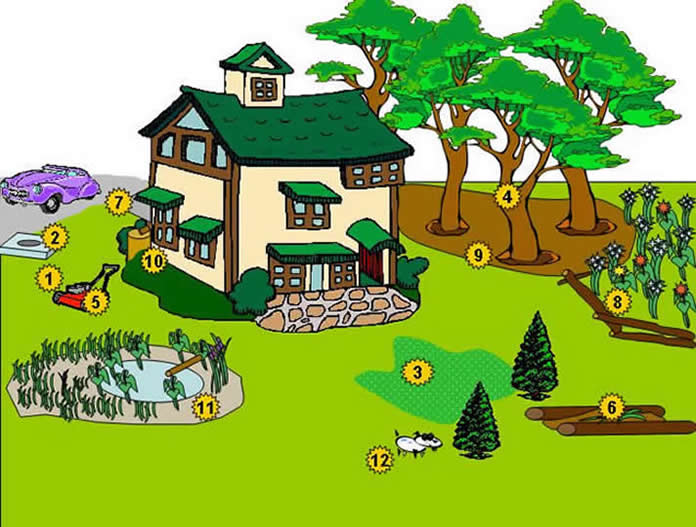|
Stormwater PSA Video Contest
TMDL Information
Stormwater 101
Watershed Events
Information Clearinghouse
Low
Impact Development
Show-Me
Yards & Neighborhoods
Do
I live in the Hinkson Creek Watershed?
Rain Gardens
Calendar
of Events
Report
a Spill/ Poor Erosion Control
Stakeholder
Committee
|
Show-Me
Yards & Neighborhoods
A watershed is the area of land that drains to a particular body of water.
A raindrop falling on a parking lot at the University, the rooftop of
the Daniel Boone library, or a yard on East Campus will all eventually
find their way into Hinkson Creek, which drains roughly 60% of the city
of Columbia . Chances are, if you live in Columbia, the raindrop falling
on your yard will wind up in Hinkson Creek too. The big question is: What
shape is that raindrop in after leaving your premises?
Many
of the things we put on our yards don’t stay on our yards, particularly
after a hard rainstorm. Fertilizers, pesticides and herbicides, de-icing
salts, lawn trimmings, and soil itself often migrates from our yards unintentionally.
Considering there are now nearly 90,000 of us living in the city, even
small amounts of pollution from each of our homes can add up to quite
a bit, especially since most will eventually flow into Hinkson Creek.

A dozen
things you can do for your watershed...
| 1.
Mow high…typically to 3 or 4 inches |
7.
Check streets & sidewalks after applying lawn products; sweep
excess into lawn |
| 2. No litter
(or oil, or old paint)!- storm sewers drain to streams |
8. Plant native
plants |
| 3. Clover is
okay; it provides nitrogen to your
lawn |
9. Put large
mulch circles beneath trees and around beds |
| 4. Increase the
amount of tree cover in your yard |
10. Install rain
barrel(s) |
| 5. Sharpen mower
blade at least once a year |
11. Install a
rain garden to catch roof runoff |
| 6. Compost grass
clippings and/or leaf litter at home, use for your landscaping |
12. Naughty dog!-
Clean up pet waste |
So what else can you do? Well,
lots of things. A good first step is to join our Show-Me Yards project.
Our advisory committee has assembled a checklist of good yard management
practices, and has assigned points, actually “inches”, for each one. Check
out the good management practices compiled by our committee, below, and
their value in inches. If you achieve an entire “Yard” by accumulating
36 inches of good practices, you're doing a decent job managing your stormwater.
A good second step is to be tolerant.
A monocrop of a single species of grass does not occur naturally in nature.
It will not occur in your yard, either, without intensive management,
which usually means intensive use of synthetic chemicals. Likewise, there
will always be a certain number of "pest" insects in your yard. Before
reaching for the pesticide, determine if they are really doing any damage.
Mow
high- 3 to 4 inches or highest setting |
5” |
Sharpen
mower blade at least once per summer |
2” |
Never
mow more than 1/3 of the height of your lawn |
2” |
“Don’t
Bag It”- Leave clippings on lawn. Mow over leaves in the fall.
|
3” |
Overseed
bare spots in early spring or early fall |
2” |
Measure
your yard (one adult pace = approximately 3 feet) |
5” |
Use
organic herbicide/pre-emergent (such as corn gluten or 20% vinegar)
|
5” |
Use
a rain gauge to track rainfall and avoid unnecessary watering |
1” |
Install
a rain barrel |
5” |
Install
a rain garden |
8” |
Percent
of yard in tree cover with no bare soil underneath (2” per 10%
of yard, 10” max)* |
* |
Identify
pests before taking action |
3” |
Reduce
use of lawn chemicals by changing cultural practices, and apply
according to directions |
5” |
Have
a soil test done. Apply nutrients per recommendations. |
8” |
Check
streets & sidewalks after applying lawn products; sweep excess
into lawn, not the street. |
3” |
Properly
dispose of old lawn care products at household hazardous waste collection
site |
4” |
Clean
up pet waste on lawns |
2” |
Compost
or mulch yard waste, grass clippings and/or leaf litter at home
|
3” |
Include
native plants (1” per 10% of yard, rounding up)* |
* |
Mulch
circles beneath trees and around beds |
3” |
Replace
synthetic landscape fabric with natural fiber such as newspaper. |
2” |
Attend Show-Me Yards workshop or take an online tutorial at http://www.clemson.edu/cyn/nine.aspl |
6” |
Total |
|
|

